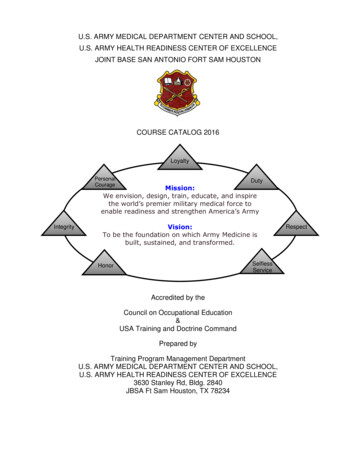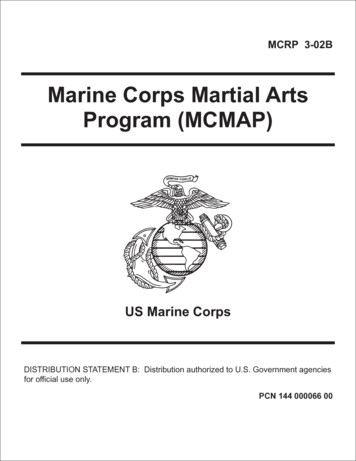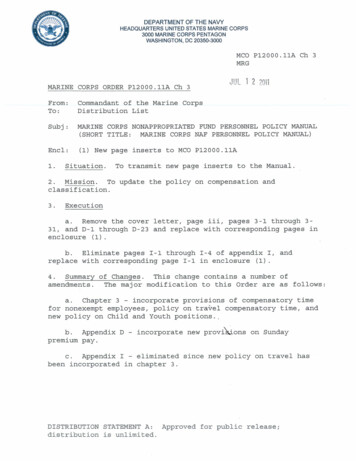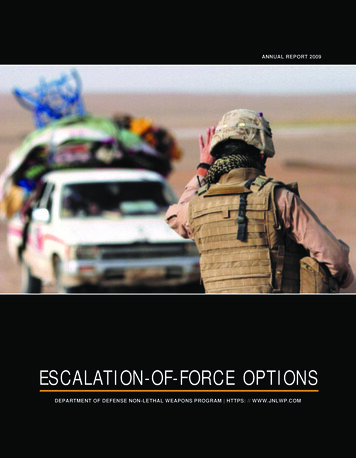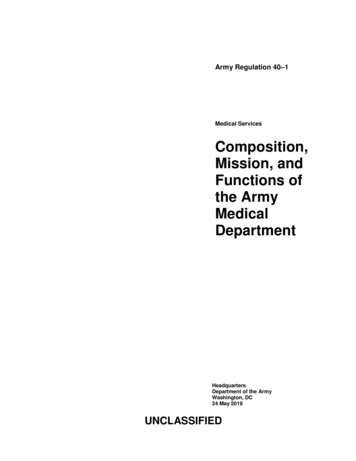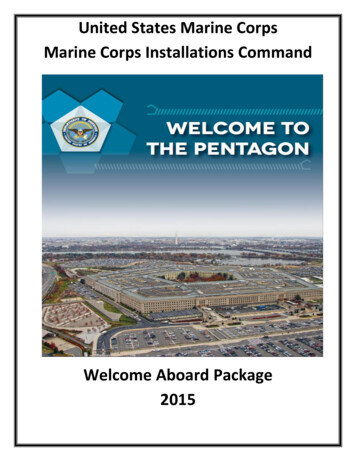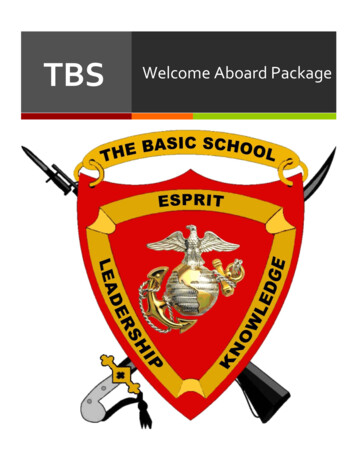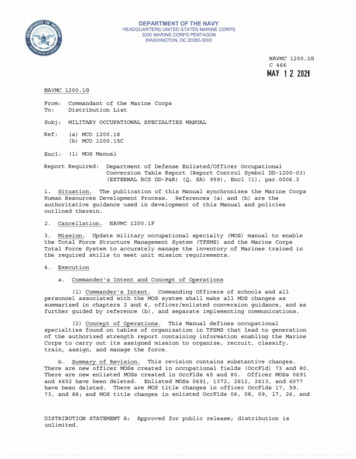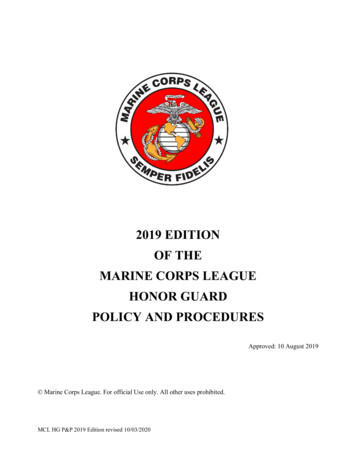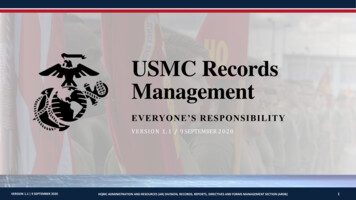
Transcription
USMC RecordsManagementEVERYONE’S RESPONSIBILITYV E R S I O N 1 . 1 / 9 SEPTEMBER 2 0 2 0VERSION 1.1 9 SEPTEMBER 2020HQMC ADMINISTRATION AND RESOURCES (AR) DIVISION, RECORDS, REPORTS, DIRECTIVES AND FORMS MANAGEMENT SECTION (ARDB)1
IntroductionRecords are created across every MOS and throughout every facet of theMarine Corps.Their management is not strictly an administrative function, created andmanaged only by the G-1 and S-1 sections. EVERYONE – regardless of rank orbillet – handles records, and EVERYONE is obligated to manage and disposeof them according to federal mandates.The key to records management (RM) is knowing what records you have,where they are, and how long they must be kept!VERSION 1.1 9 SEPTEMBER 2020HQMC ADMINISTRATION AND RESOURCES (AR) DIVISION, RECORDS, REPORTS, DIRECTIVES AND FORMS MANAGEMENT SECTION (ARDB)2
ObjectivesUpon the completion of this training you will be able to:Distinguish between records and non-recordsUnderstand current RM policy requirementsIdentify your responsibility in the creation, use, maintenance, disposition,and preservation of recordsIdentify the tools/resources needed in order to apply best practices for themanagement of records and to ensure RM program complianceVERSION 1.1 9 SEPTEMBER 2020HQMC ADMINISTRATION AND RESOURCES (AR) DIVISION, RECORDS, REPORTS, DIRECTIVES AND FORMS MANAGEMENT SECTION (ARDB)3
What is a Record?Records consist of all recorded information, regardless of form orcharacteristics, made or received by a Federal agency under Federal law orin connection with the transaction of public business and preserved orappropriate for preservation by that agency or its legitimate successor asevidence of the organization, functions, policies, decisions, procedures,operations, or other activities of the United States Government or because ofthe informational value of data in them. (44 U.S.C. Sec. 3301)VERSION 1.1 9 SEPTEMBER 2020HQMC ADMINISTRATION AND RESOURCES (AR) DIVISION, RECORDS, REPORTS, DIRECTIVES AND FORMS MANAGEMENT SECTION (ARDB)4
What is a Record?Examples include:Organizational ChartsGeneral CorrespondenceAnnual ReportsAudit/Inspection ReportsDirectives/PolicyLegal opinions/decisionsApplication DesignHandbooks and ManualsPhotosEducation and training logsEmailsVERSION 1.1 9 SEPTEMBER 2020HQMC ADMINISTRATION AND RESOURCES (AR) DIVISION, RECORDS, REPORTS, DIRECTIVES AND FORMS MANAGEMENT SECTION (ARDB)5
What is a Record?Non-Records are:Documentary materials excluded from thelegal definition of recordsCopies of documents received forinformation that do not require actionUnofficial copies of documents kept forconvenience or referenceMaterials needed for exhibition in librariesArticles, journals, working documents (i.e.rough drafts, notes, cards etc.)VERSION 1.1 9 SEPTEMBER 2020HQMC ADMINISTRATION AND RESOURCES (AR) DIVISION, RECORDS, REPORTS, DIRECTIVES AND FORMS MANAGEMENT SECTION (ARDB)6
What is a Record?Non-Records are:Routing/transmittal sheets that add no information to thetransmitted materialPersonal papers or notes which are not prepared for, usedfor, or communicated during government businessShopping List: Item 1 Item 2 Item 3The “personal papers” category does not apply tocalendars, appointment books, schedules, logs, diaries,and other records documenting meetings, appointments,telephone calls, trips, visits, and other activities of Federalemployees while serving in an official capacity, if they areprepared for, used for, circulated, or communicated duringGovernment businessVERSION 1.1 9 SEPTEMBER 2020HQMC ADMINISTRATION AND RESOURCES (AR) DIVISION, RECORDS, REPORTS, DIRECTIVES AND FORMS MANAGEMENT SECTION (ARDB)7
What is Records Management?RM is the management of information in organizations as records arecreated, maintained, used, retained, stored, inspected, destroyed orpreserved.RM enables the Marine Corps to be more efficient, accountable,responsive, and operationally ROYINGPRESERVINGRecordsManagementVERSION 1.1 9 SEPTEMBER 2020HQMC ADMINISTRATION AND RESOURCES (AR) DIVISION, RECORDS, REPORTS, DIRECTIVES AND FORMS MANAGEMENT SECTION (ARDB)8
Why Manage Records?To document and preserve the history andlegacy of Marines and the Marine CorpsTo document an organization’s mission-set,function, policy, decisions, procedures andessential transactionsTo protect the legal and financial rights of thegovernment and persons directly affected byMarine Corps activitiesVERSION 1.1 9 SEPTEMBER 2020HQMC ADMINISTRATION AND RESOURCES (AR) DIVISION, RECORDS, REPORTS, DIRECTIVES AND FORMS MANAGEMENT SECTION (ARDB)9
How are Records Managed?Records are managed according to theirlifecycle. Organizations create documents intheir day to day functions. Documents aremodified, updated, or moved across theorganization(s) to allow for collaborative input.Once a document is finalized, it is declared asan official record and retained according to itsappropriate disposition schedule. In the finalstages of a record’s lifecycle, it is eitherdestroyed or sent to the National Archives andRecords Administration (NARA) for permanentretirement/preservation.VERSION 1.1 9 SEPTEMBER 2020Creation ofDocumentMaintenanceand UseDeclared asa MC ADMINISTRATION AND RESOURCES (AR) DIVISION, RECORDS, REPORTS, DIRECTIVES AND FORMS MANAGEMENT SECTION (ARDB)10
How are Records Managed?Department of the Navy (DON) Record Schedules contain a description of the recordas well as its NARA approved disposition (i.e. what to do with that record upon thecompletion of its lifecycle).(Ex. charts, manuals or other records depicting the internal organization, relationships,function etc., cut off at the end of calendar year. Transfer to NARA 25 years after cutoff).Records are categorized by record series (chapters), grouped together by subject orfunction, activity, media format, document the same action or other commonrelationship(Ex. Intelligence Reports, Operating Plans, Awards etc.)Where a record breaks or ends its lifecycle is referred to as the cut-off; usually occursat the close of a fiscal or calendar year or event (i.e. investigations) in order to allow therecord to be destroyed or transferred to NARA for retirement/preservation.VERSION 1.1 9 SEPTEMBER 2020HQMC ADMINISTRATION AND RESOURCES (AR) DIVISION, RECORDS, REPORTS, DIRECTIVES AND FORMS MANAGEMENT SECTION (ARDB)11
How are Records Managed?Disposition is the NARA approved schedule for the destruction of temporary recordsor transfer of permanent records to NARA; it also dictates how long to store or retainrecords on site.Sample DON Records ScheduleNo.Record Series TitleDescription of nal andFunctional ChartsOrganization and functional charts, manuals, orother records depicting the internal organization,relationships, functions, and status of activities andoffices of the U.S. Navy, U.S. Marine Corps and NavySecretariatCalendaryearPermanent:Cut off at CY.Transfer to theNationalArchives 25years aftercutoffXVERSION 1.1 9 SEPTEMBER 2020HQMC ADMINISTRATION AND RESOURCES (AR) DIVISION, RECORDS, REPORTS, DIRECTIVES AND FORMS MANAGEMENT SECTION (ARDB)DispositionAuthorityDAA-NU-20150005-000212
SSICs and DON Record SchedulesIt is important to distinguish between a record’s content (SSIC) and itsdisposition (record schedule).SSIC identification of record based on subject mattervs.Record Schedule disposition date affiliated with record typeEx. An appointment letter may be created in reference to training (SSIC 3300),however, it should be filed under Record Schedule 5000-1 (GeneralCorrespondence) because that is the “bucket” which handles/disposes ofappointment letters.Ex. The Marine Corps Order regarding Awards uses SSIC 1650 to identify content,however it is filed under Record Schedule 5000-8 (Directives Case Files).VERSION 1.1 9 SEPTEMBER 2020HQMC ADMINISTRATION AND RESOURCES (AR) DIVISION, RECORDS, REPORTS, DIRECTIVES AND FORMS MANAGEMENT SECTION (ARDB)13
SSICs and DON Record SchedulesSSICs stand for Standard Subject Identification CodeWhen a record is created, it is assigned the SSIC that most closely describes itssubject, purpose or significanceOnce an SSIC is assigned, use the Command Records Operational SupportSite (CROSS: https://eis.usmc.mil/sites/cross ) or the DON Record Schedule List foundon the SECNAV portal to “crosswalk” that SSIC to its corresponding RecordSchedule: ord%20Schedules/Forms/AllItems.aspxAll RMs are responsible for completing the “crosswalk” of SSICs to the DON RecordSchedules and should incorporate record schedules into their respective file plans.VERSION 1.1 9 SEPTEMBER 2020HQMC ADMINISTRATION AND RESOURCES (AR) DIVISION, RECORDS, REPORTS, DIRECTIVES AND FORMS MANAGEMENT SECTION (ARDB)14
SSICs and DON Record SchedulesThe new DON Record Schedule dispositions replace the SSIC dispositions listed withinSECNAV M-5210.1 and should now be adopted for everyday useThis reduces approximately 6,000 SSICs to 712 Record (Disposition) SchedulesRetention periods are longer than those listed in SECNAV M-5210.1RMs now manage fewer record dispositionsSince retention periods have been extended, it is important to identify the newdispositions schedules in order to prevent unauthorized destruction of recordsVERSION 1.1 9 SEPTEMBER 2020HQMC ADMINISTRATION AND RESOURCES (AR) DIVISION, RECORDS, REPORTS, DIRECTIVES AND FORMS MANAGEMENT SECTION (ARDB)15
Creating a Records InventoryA records inventory is a list of each record series within an organization. It identifies theamount of records and any problem areas that would prohibit the migration of recordsfrom paper to an electronic format. A records inventory can be created by determining:Who has records?Designate RM points of contact and create anorganizational hierarchy to capture all offices,sections, subsections etc. with recordsWhat records are created?Determine the type and value of the recordscreated and/or maintained throughout theorganization (i.e. temporary, permanent,historical, financial, administrative etc.)VERSION 1.1 9 SEPTEMBER 2020HQMC ADMINISTRATION AND RESOURCES (AR) DIVISION, RECORDS, REPORTS, DIRECTIVES AND FORMS MANAGEMENT SECTION (ARDB)16
“To get to whereyou need to be,you need to knowwhere you are at.”Creating a Records InventoryQuestions to ConsiderWhereWhere the records are located?Determine volume, storage media(i.e. system of record, hard driveetc.), and equipment used (i.e. filecabinet, computer etc.)VERSION 1.1 9 SEPTEMBER 2020WhyWhy are the records locatedthere?Consider whether or not the record’slocation is in compliance with ERMpolicy requirements; if not, whataction(s) will be taken to meet thosestandards?HowHow are the records managed?Are the records properly identified?The disposition followed? Are therecords protected, with properaccess?HQMC ADMINISTRATION AND RESOURCES (AR) DIVISION, RECORDS, REPORTS, DIRECTIVES AND FORMS MANAGEMENT SECTION (ARDB)17
Types of RecordsThere are two types of records unique to all organizations:TEMPORARYRetained for a specific time periodCan be designated short-term (less than 3 years)or long-term (greater than 3 years)Destroyed according to disposition instructionscontained within the DON Record SchedulesEx: General Correspondence or CivilianPersonnel RecordsVERSION 1.1 9 SEPTEMBER 2020HQMC ADMINISTRATION AND RESOURCES (AR) DIVISION, RECORDS, REPORTS, DIRECTIVES AND FORMS MANAGEMENT SECTION (ARDB)18
Types of RecordsPERMAMENTHas enduring value (historical,research, legal, scientific, cultural etc.)Transferred to NARA for long-termpreservation/retirementProtects the interests of the MarineCorpsEx. Official Military Personnel Filerecords, Operational Armed Conflictrecords or Organizational PoliciesDocuments Marine Corps missions,functions, responsibilities, andsignificant experiences andaccomplishmentsVERSION 1.1 9 SEPTEMBER 2020HQMC ADMINISTRATION AND RESOURCES (AR) DIVISION, RECORDS, REPORTS, DIRECTIVES AND FORMS MANAGEMENT SECTION (ARDB)19
What is the Difference?LEGAL HOLDSFROZEN RECORDSRecords held for the purpose of litigation,audit or investigationPlaced on records in the physical custodyof Federal Records Centers (FRC)Issued by General CounselDisposition temporarily suspended due tospecial circumstancesPlaced on the records in an organization’sphysical custody.Requires request for suspension andNARA approvalARDB provides Command Designated RMsnotice to suspend the normal dispositioncycle of the records mentioned in the holdnoticeVERSION 1.1 9 SEPTEMBER 2020HQMC ADMINISTRATION AND RESOURCES (AR) DIVISION, RECORDS, REPORTS, DIRECTIVES AND FORMS MANAGEMENT SECTION (ARDB)20
File PlanThe starting point for an organization’s RM ProgramIdentifies all records created across the organization utilizing record schedulesInspected internally (once a year) and created electronically in CROSS:https://eis.usmc.mil/sites/crossContains the following: Record Schedule, Series Title, Record Description,Disposition and Disposition Authority.An electronic file plan created in CROSS includes the format (paper orelectronic) and location (Sharedrive, SharePoint, file cabinet, desktop, Systemof Record etc.) of a record, as well as any policy exclusions that would preventa paper record’s migration to an electronic format.VERSION 1.1 9 SEPTEMBER 2020HQMC ADMINISTRATION AND RESOURCES (AR) DIVISION, RECORDS, REPORTS, DIRECTIVES AND FORMS MANAGEMENT SECTION (ARDB)21
What is Electronic Records Management?Electronic Records Management (ERM) isinformation or data files that are created andstored in a digital format through the use ofcomputers and other applications software.Electronic records managed in a Department ofthe Navy (DON) approved records managementapplications (RMA) must include the appropriatedisposition and metadata.DON Tasking, Records, and ER) is an example of an approved RMA.VERSION 1.1 9 SEPTEMBER 2020HQMC ADMINISTRATION AND RESOURCES (AR) DIVISION, RECORDS, REPORTS, DIRECTIVES AND FORMS MANAGEMENT SECTION (ARDB)22
Electronic Records ManagementPer OMB M-19-21, DOD 5015.02-STD, and NARA, all federal agencieswill manage both permanent and temporary records throughout theirlifecycle in accessible electronic formats by December 31, 2022.To meet policy requirements, ARDB has outlined a “Three PhasedApproach” to move the Marine Corps to ERM compliance.ERM tools/resources are available to support RMs in meeting NARA,DON, and USMC policy requirementsVERSION 1.1 9 SEPTEMBER 2020HQMC ADMINISTRATION AND RESOURCES (AR) DIVISION, RECORDS, REPORTS, DIRECTIVES AND FORMS MANAGEMENT SECTION (ARDB)23
Electronic Records ManagementVERSION 1.1 9 SEPTEMBER 2020HQMC ADMINISTRATION AND RESOURCES (AR) DIVISION, RECORDS, REPORTS, DIRECTIVES AND FORMS MANAGEMENT SECTION (ARDB)24
Electronic Records ManagementCROSSA SharePoint tool designed to help CDRMs standup and maintain their RM Program per MCO 5210.11Frequirements. CROSS is command focused, a “one stop shop” designed to replace traditional turnoverbinders and automate 5210 IG Functional Area Checklist. It also serves as a means of identifying allUSMC records, giving both ARDB and IGMC purview over command progress to ERM.MCTILMA customized SharePoint solution, designed to automate NARA approved disposition schedules byassigning critical metadata to records captured within SharePoint. Holds 100% of records (bothTemporary and Permanent) and automatically disposes of records according to their appropriatelifecycle.DON TRACKERThe official RM repository for DON and USMC. A licensed based system that will house long termtemporary (greater than 3 years) and permanent records until transfer to NARA. Only requiresSharePoint Site Collection Administrator (SCA) or CDRM access.VERSION 1.1 9 SEPTEMBER 2020HQMC ADMINISTRATION AND RESOURCES (AR) DIVISION, RECORDS, REPORTS, DIRECTIVES AND FORMS MANAGEMENT SECTION (ARDB)25
RM Best PracticesEstablishing best practices helps mitigate risks and ensures records are managed consistently.Obtain the support of leadership within your organization and develop standard operatingproceduresConduct a records inventory to identify all records created across the organizationEnsure records are classified by content, record type, record series, and all metadata associated withthe recordCrosswalk SSICs to the DON Record Schedules in order to apply the correct disposition to recordsCreate a file plan to document location and format of records created in your area of responsibilityUse electronic tools and resources (i.e. CROSS/MCTILM/DON TRACKER) to automate RM processesand lifecycle records managementTrain personnel on RM processes and proceduresVERSION 1.1 9 SEPTEMBER 2020HQMC ADMINISTRATION AND RESOURCES (AR) DIVISION, RECORDS, REPORTS, DIRECTIVES AND FORMS MANAGEMENT SECTION (ARDB)26
RM Policy and ReferencesDON/USMC ReferencesSECNAVINST 5210.8FDON Record Management ProgramSECNAV M-5210.2DON Standard Subject Identification Code (SSIC Manual)SECNAV M-5210.1 CH 1DON Records Management Program Records Management ManualMCO 5210.11FMarine Corps Order for Records ManagementFor a complete list of current RM Policies, refer to the Records Management Policy Matrix inCROSS at: https://eis.usmc.mil/sites/CROSSVERSION 1.1 9 SEPTEMBER 2020HQMC ADMINISTRATION AND RESOURCES (AR) DIVISION, RECORDS, REPORTS, DIRECTIVES AND FORMS MANAGEMENT SECTION (ARDB)27
RM Support StaffHQMC Records, Reports, Directives and Forms Management Section (ARDB)David Spenner – Section Head david.spenner@usmc.milGilberto Correa-Ruiz – Deputy Section Head gilberto.correaruiz@usmc.milCONTRACT SUPPORTHartwood Consulting Group Program Manager – Talia Bastien540-210-0113 talia.bastien.ctr@usmc.mil Outreach Coordinator– Leira Ortiz Velez540-210-0119 leira.ortizvelez.ctr@usmc.mil Service Desk Support – Andrew Van Corbach540-210-0128 andrew.l.vancorbach@usmc.mil Training Support Specialist – Dela Ashe540-210-0087 dela.ashe.ctr@usmc.milVERSION 1.1 9 SEPTEMBER 2020ARBD OUTREACH SUPPORT smb hqmc rm outreach@usmc.mil (703) 614-1081 / DSN 224-1081Command Records Operational Support Sitehttps://eis.usmc.mil/sites/CROSSHQMC ADMINISTRATION AND RESOURCES (AR) DIVISION, RECORDS, REPORTS, DIRECTIVES AND FORMS MANAGEMENT SECTION (ARDB)28
Ex. The Marine Corps Orderregarding Awards uses SSIC 1650 to identify content, howeveritisfiledunder RecordSchedule5000-8 (DirectivesCaseFiles). VERSION 1. 1 9 SEPTEMBER . 2020. HQMC ADMINISTRATION AND RESOURCES (AR) DIVISION, RECORDS, REPO


